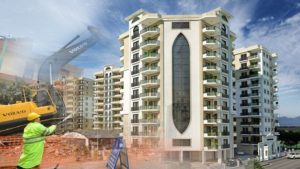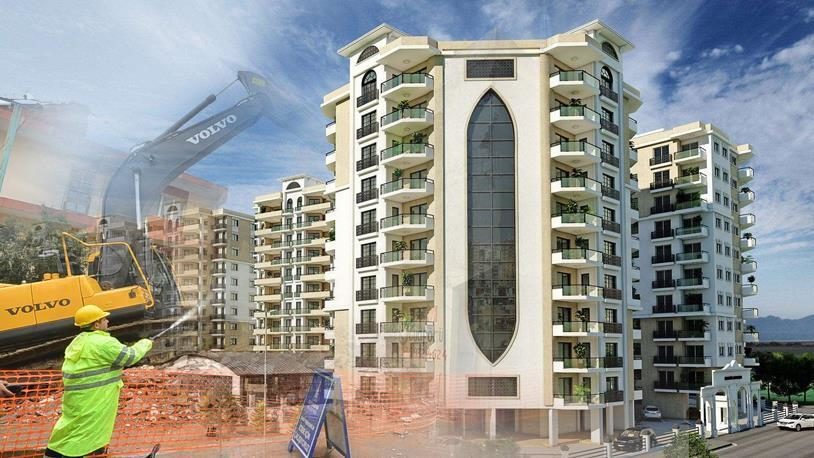URBAN TRANSFORMATION IN TURKEY
Urban Transformation in Turkey occurred in unplanned structuring within the city is seen as the solution to the landscaping of the physical and social degradation. The concept of plan Urban Transformation ‘has come to the fore as an important instrument of urban planning. Urban transformation projects are an urgent need, first of all our big cities. Urban transformation policies aim to ensure that urban people live in a healthy, quality and balanced environment. Especially in our big cities, overpopulation accumulates irregular and distorted constructions. Urban transformation projects are being produced in order to prevent such negativities and to eliminate the existing problems and to create healthy, regular and livable cities.
In a changing world, influenced by developments in information and communication technologies, cities need to tell themselves to the world beyond their physical boundaries. In this respect, there are urban renewal activities under the name of urban transformation in Turkey as well as in the world in recent years. Thus, when urban transformation is made, non-functional areas are renewed, old-new harmonized, unplanned and developed urban parts are controlled and reconstructed within a certain order. The regions, which are seen as problematic in the cities, will be reorganized and a different air will be brought to the city.
Urban regeneration is not only the construction of new buildings, also includes renovation works and gentrification of the city. Urban transformation studies in our country started late compared to Europe and the world The first urban transformation studies in our country were carried out as a Dikmen Valley Urban Development Project in Ankara in the late 1980s.
Our study consists of five parts. In the first chapter, the concept of urban transformation, its development and its aims. In the second chapter, the scope of urban transformation, the types of urban transformation, the ongoing and planned projects will be discussed. In the third chapter, the legal basis of urban transformation will be discussed. In the fourth chapter, the positive and negative aspects of urban transformation and the fact of earthquake will be mentioned. The final section is designed as a result and evaluation.
SCOPE OF THE URBAN TRANSFORMATION, TYPES, COMPLETED AND PLANNED PROJECTS
In the Article 73 of the Municipal Law No. 5393, it is required that the site be located within the boundaries of the municipality or the contiguous area and it should be at least 50.000 m² in order to be declared as an area of urban transformation. Besides, it is stated that with the reconstruction and restoration of the old and worn areas in accordance with the development of the city, new residential, industrial and commercial areas, technology parks, building social facilities, taking measures against the earthquake risk and implementing transformation projects to protect the historical-cultural texture. There is no provision on the criteria of the urban parts to be transformed according to which criteria and by whom. With the Law No. 5366, it is not known which criteria will be determined according to the criteria of the areas which are worn out and will be prevented. Sönmez, Şanlı, 2010: 67)
The most common use of urban transformation as an urban renewal model in our country is the restructuring of slum areas (Dündar, 2006: 65-74). Urban regeneration practices are generally unavailable, lost their historical texture, collapsed areas and rehabilitation-development plans, and the transformation of unreformed squatter areas to be used as the arrangement and use. However, with the liberal economic policies followed in the 1980s, the urban transformation practices that have been on the agenda of our country have increased and transformation has been accelerated with the improvement of participatory discourse with the cooperation of the public private sector, and the only alternative is the improvement-zoning plans (Uludağ and Özer, 2006: 35’42).
Urban regeneration, especially the over-migration of metropolises such as Ankara, Istanbul and Izmir, such as a ring around the surrounding areas of the development and development of the development of the slums, will bring vitality to the cities as well as economic social and cultural problems, which may be a package of measures to bring solutions. Old city parts, which are rich in cultural heritage but left empty and neglected for various reasons, have been destroyed by using them in a way that is wrong and damaging, and which has been developed in the future and which are composed of modified building groups, are the areas where urban transformation is necessary with poor quality features around them. While trying to create a healthy urban environment by renewing and re-functionalizing the old city parts that are trying to be based on economic developments, it should be ensured that the unplanned urban parts are taken under control and reconstructed (Özden, 2001: 4).
Article 56 of the Constitution provides for the establishment of organizational schemes within the framework of the task of urban regeneration projects and the local governments to realize the right to live in a healthy and balanced environment, and to provide the necessary financial opportunities and participation in the realization of the right to live in a healthy and balanced environment. Urban regeneration is responsible for urban regeneration projects in a process that can be realized within the scope of a strategy. In order for urban transformation to be more sound and future oriented, local governments should realize their task of creating transformation projects by sharing them with different institutions and organizations according to the physical, spatial, economic and socio – cultural characteristics of the area. Local governments should work in cooperation with a cultur Advisory Board gerek participation group, which extends from the expert to the management, to the representatives of professional chambers and to private persons, in order to protect and observe the urban cultural heritage, in the decision-making process and the implementation phases, they should move (Captain, 1981: 83).
Types of Urban Transformation
We can collect Urban Transformation Types under four headings.
LEGAL RESOURCES OF URBAN TRANSFORMATION
Article 56 of the Constitution; Ve that everyone has the right to live in a healthy and balanced environment and that improving the environment is the duty of the state and citizens “, Article 57; that the state is obliged to take measures to meet the housing needs within the framework of a planning framework that considers the characteristics of the cities and the environmental conditions “.It is observed that legal issues have been revised regarding the programs and projects, and the missing points have been tried to be solved especially since 2003. In addition to the laws enumerated below, the new Decree Law No. 644 and 648 and the newly created Ministry of Environment and Urbanization are also authorized for Urban Transformation.
- Municipal Law No. 5393-73. Article (2005)
- The Law on the Metropolitan Municipality of 5216 (2012)
- Law No. 5366 on the Protection and Protection of Historical and Cultural Immovable Properties by Using Renewable and Natural Properties (2005)
- Law No. 6306 on the Transformation of Areas Under Disaster Risk (2012)
- 5104 North Ankara Entrance Urban Transformation Project law (2004)
- Law No. 1164 and Amendments to the Law No. 5273
- The Slum Law No. 775 (1976)
- Zoning Amnesty Act No. 2981 (1984)
CONCLUSION
Now a serious turning point has been reached. Urban transformation is as important as the constitution; Because at least as far as the results the constitution affects our lives. urban infrastructure in Turkey, transport, social reinforcement areas, building quality and because of the earthquake are experiencing serious problems of urbanization Work is needed to place our people in healthier, safer and more peaceful cities. Many big cities are facing similar problems and quality of life is decreasing day by day and life is becoming unbearable for our people.
The earthquake remains in front of us. We should not forget the reality of earthquakes and disaster for a more healthy, sustainable and livable urbanism that will ensure the social peace of our country and to run our economy. In doing so, we must take advantage of our urbanism heritage and the urbanism that the world comes from. Sociologist, psychologist, city historian, public administrators, economists, architects, engineers and city planners to contribute to the social consensus that will increase our democracy, we must design our cities. We must work together for more sustainable and livable cities that will carry us from today to the future, where the environment, human and economy are well blended.


 English
English




